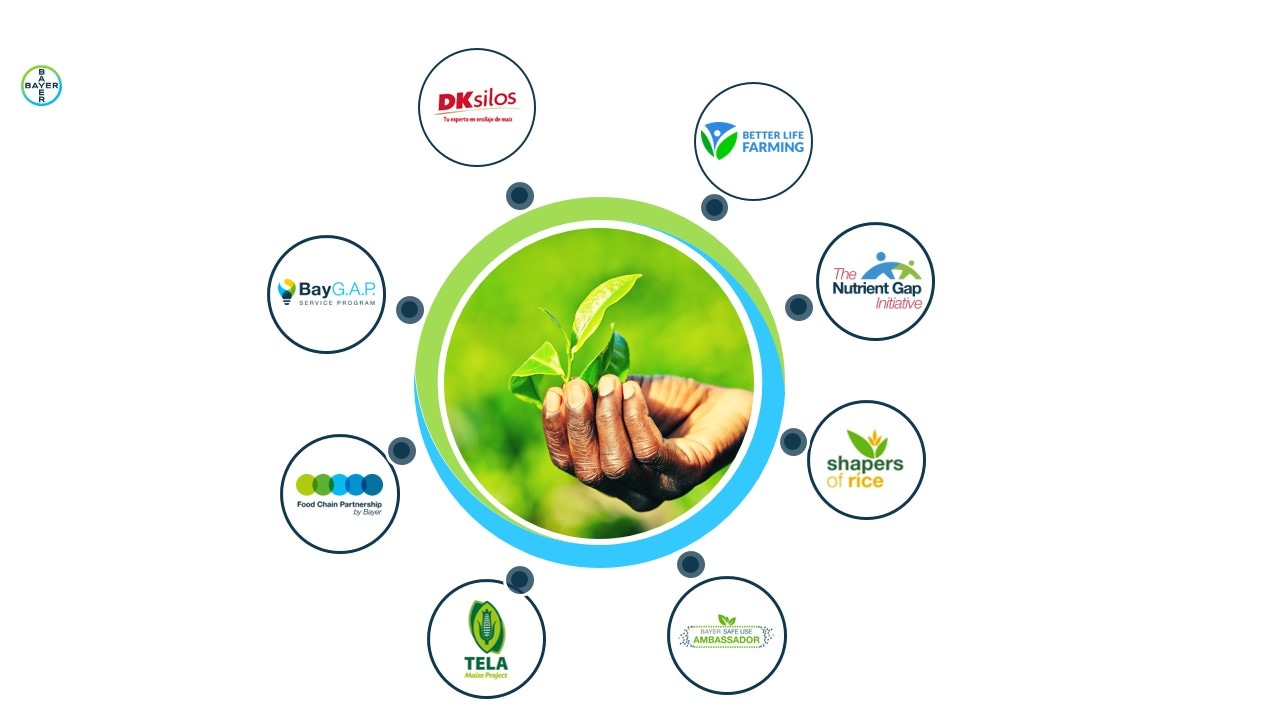Empowering 100 Million Smallholder Farmers

Empowering 100M Smallholder Farmers by 2030 with agricultural products, services, and partnerships.
Have you ever wondered who is behind the food on your plate? Meet smallholder farmers, the unsung heroes of global agriculture. Their farms are small, but their impact is huge. They are the ones working tirelessly day in day out to grow the food that keeps us all going, even in the face of countless challenges. Smallholders are real game changers in the field, for their local communities and for global food security.
Let's take a closer look at who they are and their incredible contributions.
Who are Smallholder Farmers?
A smallholder farmer is a producer who rears livestock, raises fish, or cultivates crops on a small scale. In the developing world, the typically family-owned farms operate on up to 10 hectares (24 acres), and most cultivate on less than 2 hectares (5 acres). They often rely on family labor and may keep a portion of their harvest for household consumption. Smallholder farmers may be landowners or cultivate land they do not own.
Most (84%) of the world’s 570 million farms are smallholdings. In the developing world, the typically family-owned farms cultivate only a few hectares of land. These farms are primarily located in low- and middle-income countries (LMICs), notably across Asia and Africa. Despite their modest scale, they are responsible for feeding over half of the population in their regions. According to recent research, farms smaller than 2 hectares or 5 acres produce roughly 35% of the world’s food, and provide up to 80% of the food supply in Asia and sub-Saharan Africa.
Overcoming Challenges in Agricultural Production

Smallholder farmers make a big contribution to feeding a growing global population, yet they also face significant obstacles. Challenges include limited agricultural knowledge, financial constraints, and restricted access to high-quality inputs and markets to sell their produce at a fair price. The decline in available arable land and changing weather patterns are making farming even more challenging.
What’s more, smallholder farmers often face tremendous financial risks, such as crop loss from pests or diseases, without the financial safety net of insurance or strong government support.
Holistic approaches are essential to empower smallholder farmers so that they can overcome these barriers. Only by addressing these issues can we help them to fully unlock their potential – for their own families, their communities and for global food security—for a future where their contributions will be more crucial than ever.
Contribution of Smallholders to Food Security
The world has not solved the hunger and malnutrition challenge, and the numbers are dire: Nearly 1 in 3 people worldwide lack essential vitamins and minerals. And around 733 million suffer from hunger, which means they go to bed hungry. Smallholders and their families may be affected themselves. Yet we look to them to produce more nutritious food for a growing population with less environmental impact and less resources.
At Bayer, we are driven by our mission “Health for all, hunger for none”. We believe that good nutrition is rooted in a diverse and balanced diet. Our business supports the production of a wide variety of food crops, from staple grains like corn, rice and wheat to fruits, vegetables, pulses, and nuts. We also support the production of grain products for feeding livestock which provide quality proteins like meat, milk and eggs. Our portfolio of innovative products and solutions, including seeds, crop protection products and digital tools, empowers farmers to produce these high quality, nutritious foods for people and animals in a sustainable and increasingly regenerative way.


With our portfolio and our people on the ground we actively contribute to advancing towards the UN’s Sustainable Development Goal #2: Zero Hunger.
Our Target: Empowering 100 Million Smallholder Farmers
Recognizing the vital role of smallholder farmers for global food security and the challenges they face, we are targeting to support 100 million smallholder farmers in low- and middle-income countries (LMICs) by 2030. We focus on improving access to agricultural products, services, and partnerships. This target is central to our company’s Sustainability Targets.
Our approach prioritizes creating market models that reduce risks for all stakeholders, with smallholder farmers at the core. By enhancing their access to the agricultural value chain, boosting productivity and income, and building resilience, we aim to strengthen food security in LMICs.
This is not just a pledge; it’s action. We are continuously expanding our initiatives to meet the unique needs of smallholder farmers worldwide, offering modern products, digital tools, financing, capacity building, market access, and more.
Here’s a glimpse of how we empower smallholders.
To enhance their operations, we are helping smallholder farmers afford, adopt, and benefit from sustainable and innovative farming solutions through interventions in 4 focus areas:
- Empowering Farmers with Knowledge and Insights
Smallholder farmers need access to modern technology and practices to improve their farming practices and better support their communities. Digital tools like FarmRise and BayG.A.P. provide valuable insights and help farmers make informed decisions. - Building Partnerships and Access to Finance & Markets
Collaboration is key to create comprehensive solutions along the value chain. Recognizing this, we partner with industry stakeholders to provide small farms access to vital resources such as finance, markets, and healthcare services. Initiatives like the Better Life Farming Alliance exemplify our commitment to this approach. - Tailoring Solutions to Smallholder Needs
We prioritize developing solutions that are tailored to the unique context of smallholder farming. From seed innovations like more water efficient TELA maize to pest control, disease prevention, and weed management, we provide farmers with the tools they need for better and sustainable agricultural practices. - Digital Tools
We support smallholder farmers by giving them access to digital tools that enable them to improve their productivity and sustainability. Through our initiatives, we offer mobile applications and digital advisory services that deliver real-time weather data, crop protection advice, market insights, and more. Access to additional information can help farmers make informed decisions, improve crop yields, and increase their income.

Smallholder-Centric Solutions

At Bayer, we recognize that for farmers, farming is not just about producing food—it’s about sustaining life and ensuring a sustainable future for all. Every seed a farmer plants is a symbol of hope, and every harvest reflects their resilience.
We are targeting to supporting millions of smallholder farmers by putting them at the center of our efforts. Together with partners, we provide them with tools and resources that help to produce more with fewer inputs, and become more resilient to the effects of climate change. Sustainable agricultural practices can help farmers produce more and at the same time restore more.
Learn more about some of our initiatives.
Global Initiatives Impacting Farmers' Lives
Our global initiatives are making a real and measurable impact. They are tailored to address the specific needs and challenges faced by farmers in different regions and crops. Designed with farmers in mind, these programs provide effective, practical solutions that are helping to transform agricultural practices worldwide.
But don’t just take our word for it—hear directly from the farmers themselves. Their stories highlight the meaningful improvements and positive change these initiatives are bringing to their farms and communities. Explore how our efforts are shaping a better future, one farmer at a time.
"I would like to tell farmers who have not yet been trained that since coming to the training, we know how to manage our farms correctly and safely. We learn about storage management, and the importance of protection for our (producer) health, and consumers too. I would like everyone to receive good information like this.”
Sermsak Ariyakunti
Durian Farmer, Thailand
“In times of drought, silage helps a lot to feed the animals. DKsilos had allowed us to be more prepared and not worry as much.”
Female cattle rancher, Honduras
“TELA Maize has reduced my costs on farm chemicals. It withstood the long dry spell in July and August, which devastated other farms. Many farmers lost their crops to drought and pests, but my field remained healthy and productive.”
Tamiru Danbaba
Farmer in Niger State, Nigeria
“I have regular income from tomato farming which means I can plan to pay for expenses like even education for myself without worry.”
Male tomato farmer
Kenya
“They told me that in order to keep my baby healthy, I should take the vitamins every day. My baby is healthy, energetic and very talkative.”
Kimberly Gencianos
The Philippines
“I have paid my debts from the profit that I earned. In fact, a month ago my son was hospitalized, and I managed to pay for it without having to ask anyone for money.”
Female BLF farmer
India
“Direct Seeded Rice saves water and labor cost against the conventional puddling method. Every farmer (in my village) is motivated to do DSR this year!”
Surinder Singh
Machhrauli village, Yammunagar, India
Bayer Safe Use Ambassador is a unique platform that brings medical and agriculture professionals together to advance the safe use of agricultural inputs among smallholder growers.

In 2024, we reached 52 million smallholder farmers
In 2024, together with our partners, we supported 52 million smallholder farmers in LMICs with our products and services.
The Bayer Foundation funds the Digital Farmer II program of our partner Mercy Corps Agrifin together with the Bill & Melinda Gates Foundation and Deutsche Gesellschaft für Internationale Zusammenarbeit (GIZ). This leverages the spread of digital technologies to develop more efficient digital information and financial products and services for smallholder farmers. The program achieved its goal of serving up to five million registered users in Nigeria, Kenya and Ethiopia set for 2025 ahead of schedule. In 2024, we reached some 4.1 million smallholder farmers via non-commercial partnerships.
In November 2024 the Bayer Foundation, with the funding of Bayer Crop Science, signed a grant agreement with The Pula Foundation to support the 10 million Resilient Farmer Initiative from 2025 through 2030. The initiative has the target of insuring 10 million smallholder farmers against climate risks in seven countries in Africa and Asia by 2030.
Read more about Our Targets & Our Progress.
Read more about the Smallholder Reach Methodology in the Method Paper Smallholder Reach (PDF)

For more information, please contact:
Global Smallholder Farming
Crop Science Division, Monheim, Germany
Email: smallholder@bayer.com

















